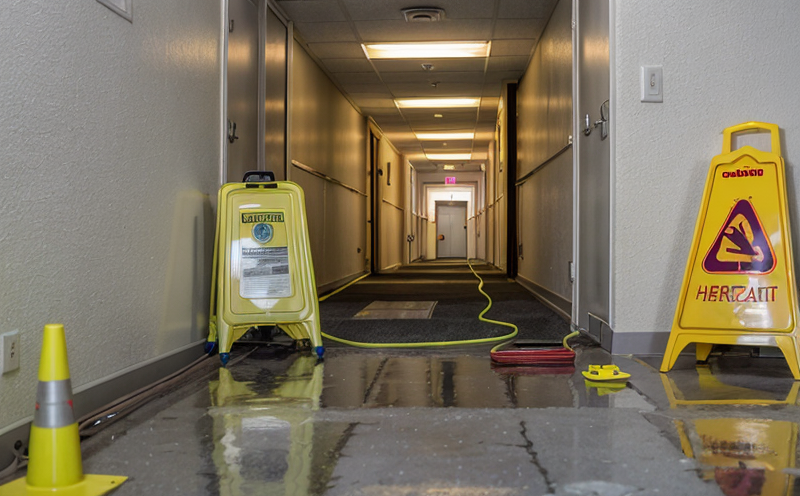EN 60079 31 Dust Ignition Protection Compliance Testing
The EN 60079 series of standards is specifically designed to ensure that electrical and electronic equipment used in potentially explosive atmospheres remains safe under all operating conditions. This includes testing for dust ignition protection, which is crucial for the safety of industrial facilities where combustible dusts are present.
EN 60079-31 provides detailed requirements and guidelines for ensuring that electrical apparatus can be used in environments classified as Zone 22 or Class II, Division 2. These zones and classes refer to areas where there is a risk of combustible dust being present under certain conditions.
The standard focuses on the design and construction of equipment to prevent ignition sources from initiating an explosion. This involves ensuring that any sparks, arcs, or overheating does not occur within these classified areas. Compliance with EN 60079-31 is essential for manufacturers wishing to market their products in hazardous locations.
The testing process under this standard involves several steps, including the preparation of test specimens and the use of specialized equipment designed to replicate real-world conditions. The specimen is subjected to various stress tests that simulate operational scenarios where there might be a risk of ignition. These tests are conducted under controlled laboratory environments to ensure accurate and repeatable results.
Accurate interpretation of the standard involves understanding the specific requirements for testing, such as the classification of dust types (e.g., IIC, IIIC) and the environmental conditions in which the equipment will be used. The test methods outlined in EN 60079-31 are designed to assess whether the equipment can withstand these conditions without posing a risk.
Once testing is complete, detailed reports are generated that document all aspects of the testing process and results. These reports are critical for manufacturers as they provide evidence of compliance with international safety standards. The report will typically include information on the test setup, specimen preparation, testing parameters, and any deviations from expected behavior.
For quality managers and compliance officers, understanding EN 60079-31 is essential to ensure that products meet regulatory requirements. R&D engineers benefit from this knowledge as it guides them in designing equipment that not only meets but exceeds safety standards. Procurement teams can rely on this expertise to select suppliers who are capable of producing compliant products.
In summary, EN 60079-31 is a vital standard for ensuring the safe use of electrical and electronic equipment in hazardous locations. Compliance testing under this standard is not just an obligation but a critical component of risk management in industries where combustible dusts are present.
Benefits
Compliance with EN 60079-31 offers numerous benefits to manufacturers and end-users alike. For manufacturers, it ensures that their products meet the highest safety standards, thereby enhancing brand reputation and marketability. It also facilitates easier access to international markets where these standards are required.
For quality managers and compliance officers, this standard provides a clear framework for ensuring product safety. This reduces the risk of costly recalls and legal issues due to non-compliance with regulations. It also streamlines the certification process, making it more efficient.
R&D engineers can leverage this knowledge to innovate safer products that not only comply with standards but also offer enhanced performance in hazardous environments. Procurement teams benefit from knowing which suppliers are capable of providing compliant products, thus reducing procurement risks and ensuring product quality.
End-users, including workers in industrial facilities, gain peace of mind knowing that the equipment they use is designed to prevent potential explosions caused by dust ignition. This contributes to a safer working environment and reduced risk of accidents or incidents.
Environmental and Sustainability Contributions
Compliance with EN 60079-31 aligns closely with broader environmental and sustainability goals. By ensuring that equipment is designed to prevent dust ignition, this standard helps reduce the risk of fires and explosions in industrial settings. This not only prevents damage to property but also minimizes potential harm to people.
The reduction in accidents and incidents leads to lower insurance premiums for businesses operating in hazardous locations. Additionally, by promoting safer operations, EN 60079-31 contributes to a more sustainable workplace culture where safety is prioritized.
For manufacturers, compliance with this standard can lead to reduced liability costs and improved reputation, which are key factors in maintaining long-term sustainability. By selecting suppliers who meet these standards, procurement teams contribute to the overall sustainability efforts of their organizations.
Use Cases and Application Examples
The application of EN 60079-31 is broad and covers a variety of industries where combustible dusts are present. Some key use cases include:
Petrochemical Industries: In refineries, petrochemical plants, and other facilities where hydrocarbon dusts are generated, ensuring the safety of electrical equipment is critical.
Agricultural Processing Facilities: Mills, grain processing units, and food manufacturing plants often use equipment that could potentially generate sparks or arcs in dusty environments.
Mining Operations: In coal mines and other mining operations where fine dust particles are common, ensuring the safety of electrical equipment is paramount for preventing explosions.
Pharmaceutical Manufacturing: Processing areas in pharmaceutical plants can generate dust that could pose a risk if not properly managed. Ensuring that all electrical equipment complies with EN 60079-31 standards helps prevent accidents.
Paper and Pulp Industries: In paper mills, pulp processing units, and similar facilities where wood fibers are present, ensuring the safety of electrical equipment is crucial to prevent fires and explosions.





